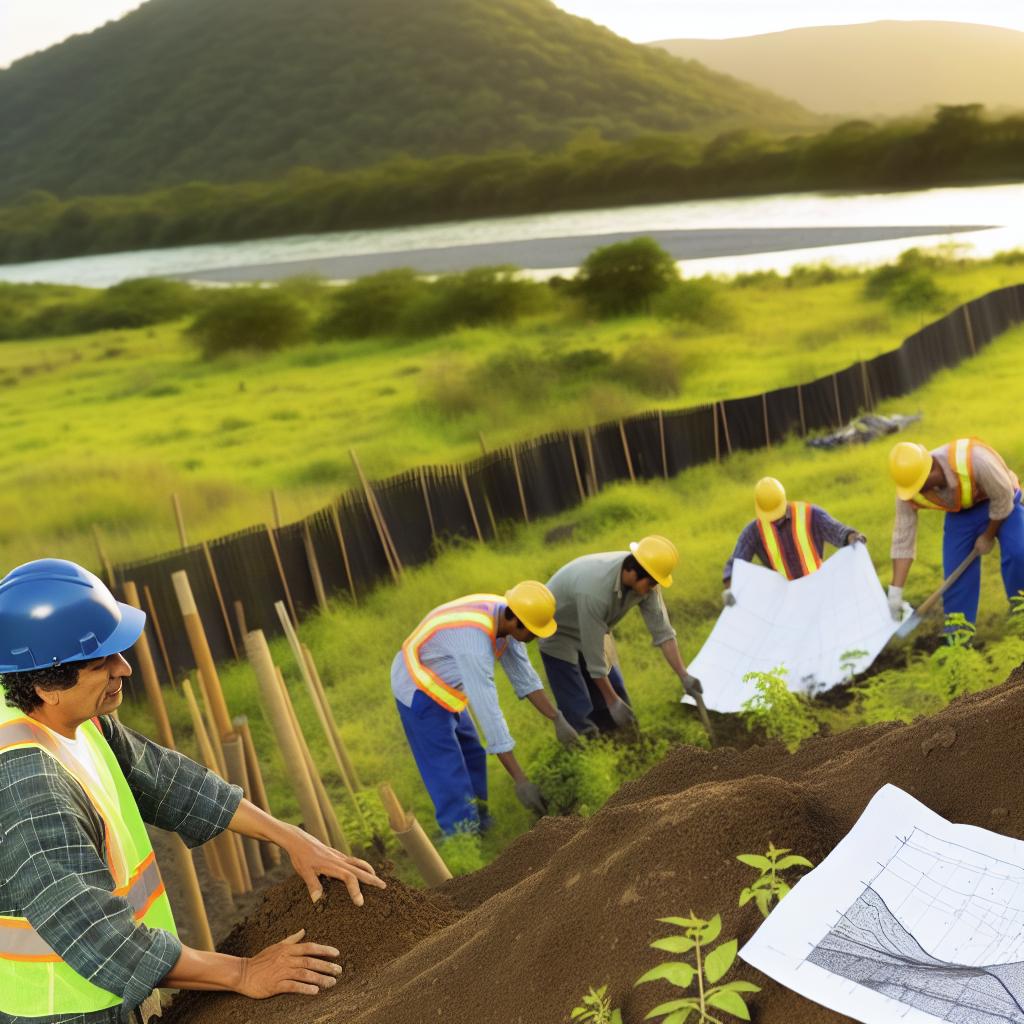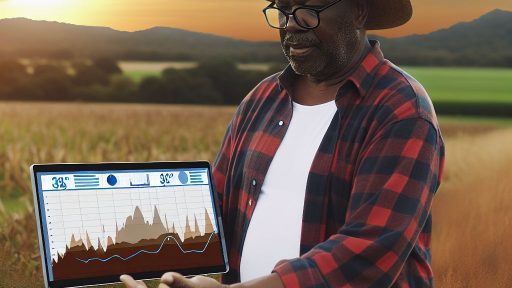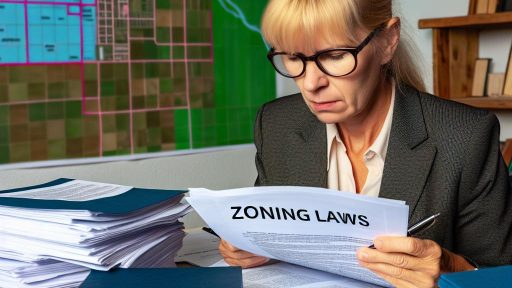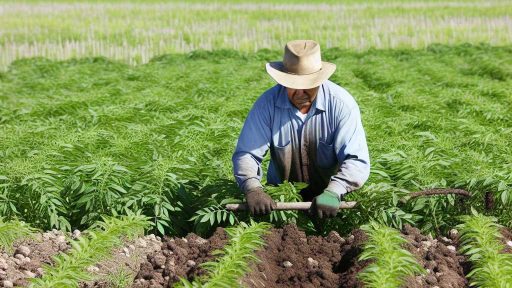Introduction to Soil Erosion
Soil erosion is a significant environmental challenge today.
It involves the removal of the upper layer of soil.
This process occurs due to various natural and human-induced factors.
Understanding the causes of soil erosion is crucial for effective control.
Causes of Soil Erosion
Natural causes include wind and water erosion.
Heavy rainfall rapidly washes the soil away.
Additionally, wind can blow topsoil off agricultural fields.
Human activities exacerbate this issue significantly.
Deforestation removes trees that stabilize the soil.
Agricultural practices, such as tilling, disturb the soil structure.
Urbanization leads to increased runoff and soil displacement.
Consequences of Soil Erosion
The impact of soil erosion is profound and far-reaching.
It reduces soil fertility, affecting agricultural productivity.
This, in turn, leads to food insecurity in vulnerable regions.
Furthermore, sedimentation clogs rivers and water bodies.
Transform Your Agribusiness
Unlock your farm's potential with expert advice tailored to your needs. Get actionable steps that drive real results.
Get StartedThis disrupts aquatic ecosystems and decreases water quality.
Moreover, increased erosion contributes to the loss of land.
Consequently, it poses a threat to sustainable real estate development.
The Importance of Soil Health in Sustainable Real Estate Development
Understanding Soil Health
Soil health is vital for successful real estate development.
Healthy soil supports plant growth and biodiversity.
It plays a crucial role in water filtration and nutrient cycling.
Additionally, healthy soil prevents erosion and degradation.
Impact on Construction Practices
Building on healthy soil enhances project longevity.
It reduces the risk of structural damage over time.
Furthermore, healthy soil improves site drainage and stability.
This aspect is particularly important in urban settings.
Environmental Benefits
Healthy soil contributes positively to the ecosystem.
It supports wildlife habitats and enhances urban green spaces.
Moreover, it helps in carbon sequestration efforts.
This capacity mitigates climate change impacts significantly.
Economic Advantages
Investing in soil health can lead to cost savings.
Healthy sites require less maintenance in the long run.
Moreover, properties on healthy soil see increased value.
This trend attracts eco-conscious buyers and investors.
Best Practices for Maintaining Soil Health
Adopting sustainable practices is essential for soil health.
Implementing cover crops reduces erosion and improves soil structure.
Additionally, reducing chemical inputs can enhance biodiversity.
Furthermore, proper drainage systems are critical in urban developments.
Community Engagement
Engaging with community members fosters collective soil health efforts.
Showcase Your Farming Business
Publish your professional farming services profile on our blog for a one-time fee of $200 and reach a dedicated audience of farmers and agribusiness owners.
Publish Your ProfileWorkshops and informational sessions can spread awareness.
Moreover, community gardens can promote healthy soil practices.
This involvement creates a shared commitment to sustainability.
Common Soil Erosion Control Methods: An Overview
Understanding the Importance of Soil Erosion Control
Ssoil erosion can devastate landscapes and ecosystems.
It affects soil fertility and water quality.
Implementing erosion control methods enhances sustainable development.
These methods protect soil and promote construction integrity.
Vegetative Cover
Vegetative cover is a widely-used method for soil erosion control.
This technique employs grass, shrubs, and trees to stabilize soil.
Plants absorb rainwater, reducing runoff and soil loss.
Additionally, roots bind the soil, enhancing structural integrity.
Examples include using native ground cover plants and reforestation projects.
Erosion Control Blankets
Erosion control blankets serve as protective coverings for soil.
These blankets come in various materials, including natural fibers and synthetic options.
They help prevent soil displacement during heavy rains.
Furthermore, they promote seed germination, enhancing vegetative cover.
Implementing these blankets speeds up rehabilitation of disturbed areas.
Drainage Management
Effective drainage management is essential for controlling soil erosion.
This method involves designing landscapes to direct water flow.
Properly placed ditches and drains reduce water accumulation on slopes.
They also prevent excessive runoff that can erode soil layers.
Implementing swales or contour drainage can significantly reduce erosion risks.
Contour Farming and Terracing
Contour farming involves plowing along the contours of a slope.
This technique reduces water runoff and soil erosion.
Similarly, terracing creates flat areas on slopes, minimizing water flow speed.
Both methods enhance water retention while providing flat surfaces for farming.
They are effective in hilly areas where erosion risk is higher.
Rock and Gravel Barriers
Rock and gravel barriers are physical structures that slow water flow.
They trap sediment and prevent it from washing away.
These barriers can be custom-built to fit specific landscape needs.
Additionally, they are effective in controlling erosion on slopes and during heavy rain.
Proper maintenance of these structures ensures their effectiveness over time.
Regular Maintenance and Monitoring
Regular maintenance is crucial for all soil erosion control methods.
Periodic assessments identify areas needing intervention.
This proactive approach ensures long-term effectiveness of erosion control measures.
Monitoring also adapts methodologies to evolving environmental conditions.
Engaging local communities can enhance observation efforts and foster responsibility.
Explore Further: Best Irrigation Practices for Reducing Water Waste in Farming
Vegetative Solutions: Using Plants to Combat Soil Erosion
Importance of Vegetative Solutions
Vegetative solutions play a critical role in controlling soil erosion.
They improve soil stability and water retention.
Showcase Your Farming Business
Publish your professional farming services profile on our blog for a one-time fee of $200 and reach a dedicated audience of farmers and agribusiness owners.
Publish Your ProfileMoreover, plants act as natural barriers against erosion forces.
Types of Vegetative Solutions
Grasses and Groundcovers
Grasses and groundcovers are often the first line of defense.
They establish dense root systems that hold soil together.
Additionally, they provide a protective layer against rainfall impact.
Trees and Shrubs
Trees and shrubs offer significant benefits for erosion control.
Their extensive root networks stabilize the soil effectively.
Furthermore, they create windbreaks that reduce soil loss.
Perennial Plants
Perennial plants are excellent for long-term erosion control.
They thrive in various environmental conditions.
This adaptability enhances soil structure and prevents erosion.
Implementation Strategies
Site Assessment
Before implementing vegetative solutions, conduct a site assessment.
Identify areas of high erosion risk.
This step is crucial for selecting appropriate plant species.
Choosing the Right Species
Selecting native species is vital for success.
They are better adapted to local conditions.
Additionally, they support local wildlife and ecosystems.
Planting Techniques
Use proper planting techniques to enhance growth and stability.
Ensure adequate spacing to promote healthy root development.
Water the plants regularly to establish their growth.
Maintenance and Monitoring
Regular maintenance is necessary for effective erosion control.
Monitor plant health and replace any dead specimens promptly.
Furthermore, maintain soil health through organic amendments.
Benefits Beyond Erosion Control
Vegetative solutions offer numerous environmental benefits.
They enhance biodiversity and improve air quality.
Moreover, they provide habitats for wildlife and aesthetic value.
Case Studies and Success Stories
Numerous successful projects illustrate the effectiveness of vegetative solutions.
For instance, the Riverbank Revival Project transformed eroded areas.
Additionally, the Green Roof Initiative improved urban landscapes.
Learn More: How AgTech Innovations Shape Rural Real Estate and Land Development
Structural Solutions: Engineering Approaches to Erosion Control
Retaining Walls
Retaining walls effectively prevent soil erosion on slopes.
They support the soil behind them, keeping it in place.
Additionally, they create usable land on steep terrains.
Construction materials vary, including concrete and stone.
Proper drainage behind the wall is crucial for effectiveness.
Gabion Baskets
Gabion baskets are wire mesh containers filled with rocks.
They form barriers to protect against soil erosion on slopes.
These structures absorb water, reducing runoff and stabilizing soil.
Moreover, they blend with the natural environment.
They are cost-effective and easy to install in various landscapes.
Erosion Control Blankets
Erosion control blankets provide immediate ground cover.
Showcase Your Farming Business
Publish your professional farming services profile on our blog for a one-time fee of $200 and reach a dedicated audience of farmers and agribusiness owners.
Publish Your ProfileThey help protect soil while vegetation takes root.
This method reduces runoff and promotes plant growth.
Materials include jute, coir, and synthetic fibers.
Each type offers varying degrees of strength and biodegradability.
Terracing
Terracing transforms sloped land into flat areas.
This method slows water runoff, reducing soil erosion risk.
Additionally, it creates more usable space for agricultural activities.
Proper design and maintenance enhance the effectiveness of terraces.
Soil moisture retention improves in terraced areas, promoting growth.
Vegetative Solutions
Using vegetation is a natural approach to erosion control.
Plants and roots stabilize soil with their structures.
Native plants are particularly effective for local conditions.
Cover crops can enhance soil health while preventing erosion.
Additionally, their deep roots increase soil structure and water infiltration.
Discover More: How Climate Affects Pest Control Strategies in Farmland Communities

The Role of Cover Crops in Soil Preservation
Introduction to Cover Crops
Cover crops play a vital role in soil preservation.
These plants grow during off-seasons when main crops aren’t cultivated.
They help in preventing soil erosion and nutrient depletion.
Additionally, cover crops enhance soil structure and fertility.
Benefits for Soil Health
Cover crops improve soil health in various ways.
Firstly, they reduce soil erosion by protecting the surface.
Moreover, they increase organic matter through decaying plant material.
This organic matter supports beneficial microorganisms in the soil.
Enhancing Water Retention
Cover crops significantly enhance water retention in the soil.
Their root systems create channels for water infiltration.
This process helps in reducing runoff during heavy rains.
Consequently, it allows more water to reach the root zone of plants.
Reducing Weeds and Pests
Another important role of cover crops is weed suppression.
They outcompete weeds for nutrients and light.
Furthermore, some cover crops deter specific pests naturally.
This reduces the need for chemical interventions in farming.
Types of Effective Cover Crops
Diverse cover crops complement different farming practices.
- Legumes such as clover and vetch enhance nitrogen levels.
- Grasses like rye and oats prevent soil erosion effectively.
- Brassicas such as radishes improve soil structure through root penetration.
Implementing Cover Crops in Properties
Integrating cover crops into real estate development is beneficial.
It enhances land use practices and promotes sustainability.
Developers can design landscapes incorporating these crops easily.
This strategy improves property value while preserving the environment.
Explore Further: The Role of Sustainable Practices in Agricultural Land Valuation
Integrating Erosion Control in Site Planning and Development
Understanding Erosion Control
Erosion control involves techniques to prevent soil loss during development.
This practice protects land from being washed or blown away.
Moreover, it safeguards water quality in nearby bodies.
Showcase Your Farming Business
Publish your professional farming services profile on our blog for a one-time fee of $200 and reach a dedicated audience of farmers and agribusiness owners.
Publish Your ProfileUsing effective erosion control helps maintain ecological balance.
Incorporating Erosion Control in Site Planning
Site planning requires careful consideration of natural landscapes.
Identify vulnerable areas prone to erosion before construction begins.
Utilize topographical maps to assess potential risk zones.
Engage with landscape architects to create effective designs.
Design features such as slopes and drainage systems strategically.
Selecting Appropriate Erosion Control Methods
Implement methods tailored to the site’s specific needs.
- Use vegetative cover to enhance soil stability.
- Incorporate silt fences to capture sediment runoff.
- Install terraces on slopes to reduce surface runoff.
- Implement riprap to protect vulnerable areas from erosion.
Additionally, consider using biodegradable erosion blankets for temporary coverage.
Continuous Monitoring and Maintenance
Regular monitoring ensures erosion control measures remain effective.
Inspect sites after major storms for potential damages.
Conduct routine maintenance to address any wear or failure.
Adjust strategies based on evolving conditions and best practices.
Community Involvement and Education
Engage the community in understanding erosion issues.
Host workshops to educate about effective erosion control practices.
Encourage local stakeholders to participate in planning discussions.
Building awareness fosters a collaborative approach to sustainability.
Regulatory Compliance and Best Practices
Adhere to local regulations regarding erosion control measures.
Integrate best practices as accepted by environmental agencies.
This compliance not only protects the environment but also enhances development credibility.
Maintain documentation of all erosion control activities and assessments.
Best Practices in Maintenance and Monitoring of Erosion Control Measures
Establish Regular Inspection Schedules
Conduct regular inspections to assess the effectiveness of erosion control measures.
Schedule inspections after heavy rainfall or significant weather events.
Involve trained personnel to ensure thorough evaluations.
Document findings to track improvements or ongoing issues.
Utilize Technology for Monitoring
Incorporate drones or satellite imagery for large-scale monitoring.
Use soil moisture sensors to gauge erosion risk effectively.
Leverage GIS technology to analyze site-specific data.
Implement Adaptive Management Practices
Adjust erosion control measures based on inspection results.
Respond proactively to changing environmental conditions.
Engage stakeholders in discussions about management strategies.
Educate and Train Personnel
Provide ongoing training sessions for staff regarding erosion control practices.
Share updates on best practices and new technologies in erosion control.
Encourage teamwork and communication among all involved parties.
Involve the Community
Host community workshops to raise awareness about soil erosion.
Encourage local participation in monitoring efforts.
Build partnerships with local organizations for broader outreach.
Document and Report Findings
Create detailed reports after each inspection to capture relevant data.
Share findings with stakeholders to inform future decisions.
Use reports to enhance transparency and accountability within the project.
Regularly Review Erosion Control Plans
Set annual reviews of your erosion control strategy to ensure effectiveness.
Showcase Your Farming Business
Publish your professional farming services profile on our blog for a one-time fee of $200 and reach a dedicated audience of farmers and agribusiness owners.
Publish Your ProfileModify plans based on lessons learned from previous experiences.
Consider advances in technology or methodology to strengthen efforts.
Invest in Sustainable Materials
Select eco-friendly materials for erosion control installations.
Focus on alternatives that promote ecosystem health and stability.
Regularly assess the long-term performance of chosen materials.
Additional Resources
Environmental Quality Incentives Program | Natural Resources …




